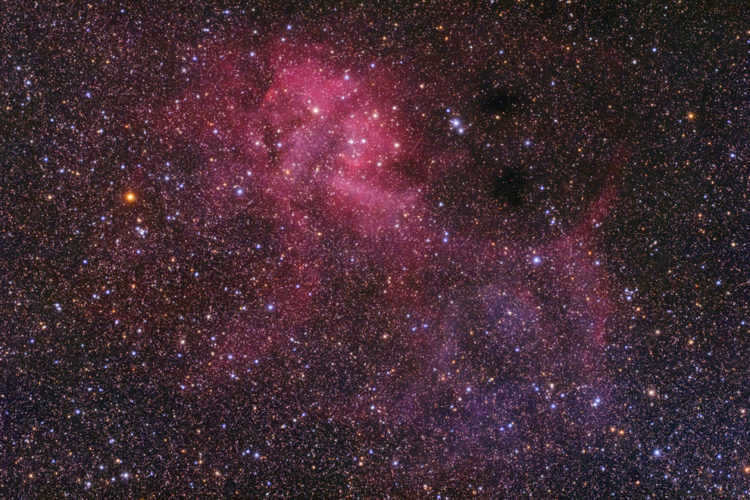
- Constellations
Cepheus (also known as Cepheus) is a constellation located in the Northern Hemisphere of the sky. It has an irregular pentagon shape. The southern part of the constellation can be found along the Milky Way. Cepheus covers an area of 587.8 square degrees in the sky and contains 148 stars that can be seen without the aid of a telescope.
Due to precession, the North Pole of the Earth is gradually moving towards Cepheus. In the year 3100, the star Alrai (γ Cep) will be located near the pole. From the years 5100 to 6500, the star Alfirk (β Cep) will be even closer to the pole. Finally, starting from 8300, the star Alderamin (α Cep) will take on the role of the North Pole star.
History
The history of this ancient constellation dates back to the Greeks, who attributed it to Eudoxus. However, it is believed that Eudoxus was only responsible for the first written description of the constellation. Notably, the constellation is also included in Claudius Ptolemy’s Almagest catalog of the starry sky.
Cepheus, the mythical Ethiopian king, is closely associated with this constellation. He was the consort of Cassiopeia and the father of Andromeda.
In Arabic maps, the constellation is referred to as Al-Multaghib, which translates to “fiery” or “ardent”. The depiction of the hero shows him resting one foot on the pole and the other on the Little Bear. He is adorned with a turban and a crown on his head. Additionally, he holds his cloak in one hand and his royal scepter in the other.
Summary
| Cepheus | |
| Latin name | Cepheus (gen. n.: Cephei). |
| Abbreviation | Cep |
| Symbol | King Cepheus |
| Direct ascent | 20 h 00 m to 8 h 00 m |
| Declination | +52° 45' to +88° 00' |
| Area | 588 sq. deg. (27th place) |
| Brightest stars (magnitude < 3 m ) | Alderamin, (α Cep) – 2.44m |
| Meteor streams | none |
| Neighboring constellations | Little Bear Dragon Swan Lizard Cassiopeia Giraffe. |
| The constellation can be seen from latitudes ranging from +90° to -2°. The most favorable time for observation is between July and September. | |
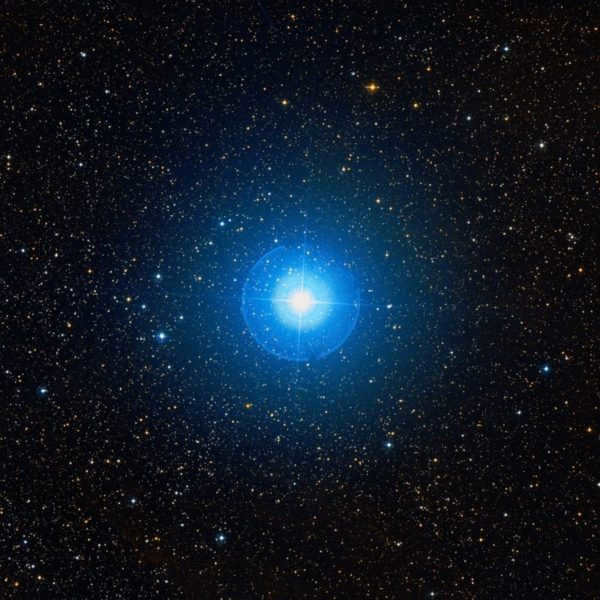
The constellation Cepheus is home to some of the most notable stars and celestial objects.
Within this constellation, you can find the third and fourth largest stars, as well as numerous double and variable stars.
One particularly prominent star in Cepheus is Alpha, also known as “Alderamin” or “right hand”. It shines as the brightest star in the constellation and holds the classification of a subgiant. In the future, it will transform into a red giant and eventually become Polaris, which it previously was back in 18000 BC. Its location near the north pole of the world only adds to its significance.
Beta of the constellation Cepheus, also known as “Alfirk” or “flock of sheep”, is the second most luminous star in its constellation. It is a pulsating variable triple star, forming a visual double star with a blue giant and a faint companion. Its primary component is the brightest star in the category of variable stars, similar to the beta star of Canis Major. Alfirk is also a member of the Cepheus beta class of variable stars, which undergo changes in luminosity due to pulsations on their surface. Beta Cepheus is situated approximately 595 light-years away from our planet.
The double star Gamma of the constellation Cepheus, also referred to as Alrai or Shepherd, is situated approximately 45 light-years away from Earth. Its primary component is an orange subgiant star, estimated to be 6.6 billion years old. The companion star of Gamma, a red dwarf, is presumed to be of the same age. In around 4,000 years, Cepheus’ gamma-ray, similar to Alderamin, will transform into a polar star.
The intriguing variable double star Delta of the constellation Cepheus, also known as “Al Radif” or “Next”, exhibits a subtle contrast in colors. It is a stable double star, comprising of a yellow giant as its main component, and a blue companion with a visual magnitude of 7.5. Additionally, Al Radif belongs to a category of variable stars like Cepheus delta, which are utilized for calculating the distance to faraway galaxies.
Mu, located in the constellation Cepheus, is a supergiant star with a deep red color. It is known as a semi-regular variable star and was given the nickname “Pomegranate Star” by William Herschel, who was captivated by its striking appearance. Mu is one of the most prominent and largest stars ever observed in the Milky Way galaxy.
Characteristics of Mu Cepheus
Mu Cepheus is part of a triple star system. Alongside the main star, there are two additional components: mu Cepheus B, which has a visual magnitude of 12.3m, and mu Cepheus C, with a stellar magnitude of 12.7m. It is worth noting that Mu Cepheus has entered the final stages of its evolution.
The process of helium burning has already commenced, leading to its conversion into carbon, providing undeniable proof of its eventual depletion. There is a high likelihood that within the next several million years, it will undergo a cataclysmic explosion, giving rise to a supernova and potentially resulting in the formation of a massive black hole originating from its core.
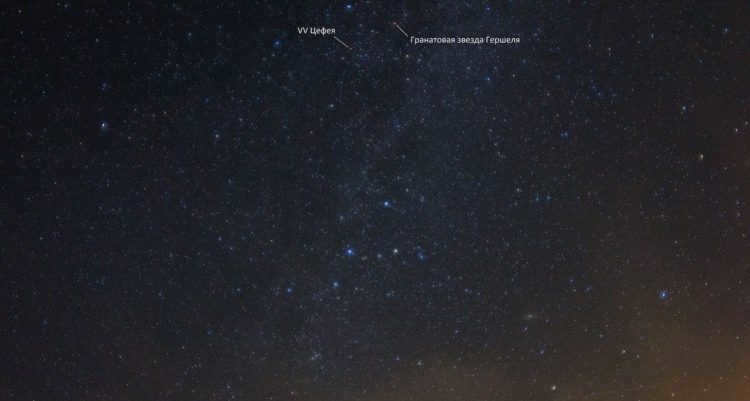
DO Cepheus, also known as Kruger 60, is another fascinating star in the constellation we are discussing. Situated approximately thirteen light years away from the Sun, this star is a binary system consisting of two red dwarfs that orbit a common center of mass. The orbital period of this rotation is nearly 45 years. The larger component of Kruger 60 is referred to as A, while the smaller one is known as B, which is a flaring star. Flares on Kruger B occur at regular intervals of 8 minutes. During these outbursts, Kruger B shines twice as brightly before returning to its normal state.
The star Kruger 60 is composed of two components, A and B, with different parameters. Component A has a mass that is approximately 27% of the mass of the Sun, and a radius that is about 35% of the radius of the Sun. On the other hand, component B has a mass that is 18% of the Sun’s mass, and a radius that is 24% of the solar radius. The average distance between Kruger A and Kruger B is 9.5 astronomical units, which is similar to the distance between Saturn and the Sun. However, due to the eccentricity of Kruger 60’s orbit, the actual distance between the components can range from 5.5 to 13.5 astronomical units.
Stars and other celestial bodies in the Cepheus constellation
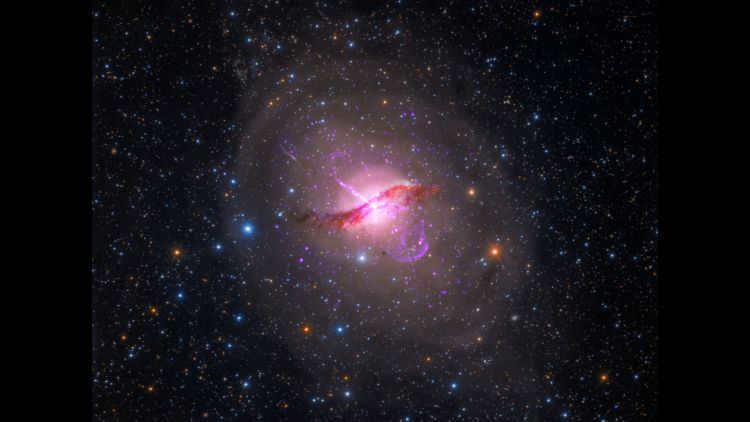
- The Fireworks Galaxy (also known as NGC 6946, Arp 29, Caldwell 12) is an intermediate spiral galaxy located in the constellation of Cepheus. It is situated at a distance of 22 million light-years and has an apparent magnitude of 9.6. The Fireworks Galaxy is positioned between the constellations of Cepheus and Swan.
- NGC 7380 is a star cluster that has been nicknamed the Wizard Nebula. It was first discovered in 1787 by Caroline Herschel. The cluster is part of a larger nebula and has a size of approximately 110 light-years. It is located 7,000 light years away from our solar system. The stars within the cluster are estimated to be no older than 5 million years, making it a relatively young open cluster.
- NGC 188(Caldwell 1) is a star cluster that was discovered 5,400 light-years away. It was first observed in 1825 by William Herschel. This cluster is considered one of the oldest known clusters and is situated 5 degrees from the North Celestial Pole.
- The Iris Nebula(NGC 7023, Caldwell 4) is a reflection nebula that has an apparent magnitude of 6.8 and is located 1,300 light-years away. It consists of a star cluster that is surrounded by the nebula. The illumination of this nebula comes from the star SAO 19158 and it is located near two relatively bright stars, T Cepheus (a Mira-type variable) and Beta Cepheus (with an apparent magnitude of 3.23).
- NGC 7129 is an area of open star formation found within a reflecting nebula that resembles a rosebud in shape. It contains approximately 130 young stars that are less than a million years old. This cluster is located 3,300 light-years away and has an apparent magnitude of 11.5.
- NGC 7142 is an open cluster situated around 6,200 light-years away with a magnitude of 9.3. It is found near the NGC 7129 nebula but is partially obscured by an interstellar cloud. This cluster is considered one of the oldest, although determining its exact age is challenging due to the uncertainty caused by interstellar reddening. What makes NGC 7142 particularly interesting is the presence of numerous young blue stars, which is unusual for an aging cluster.
The legend of the Cepheus constellation
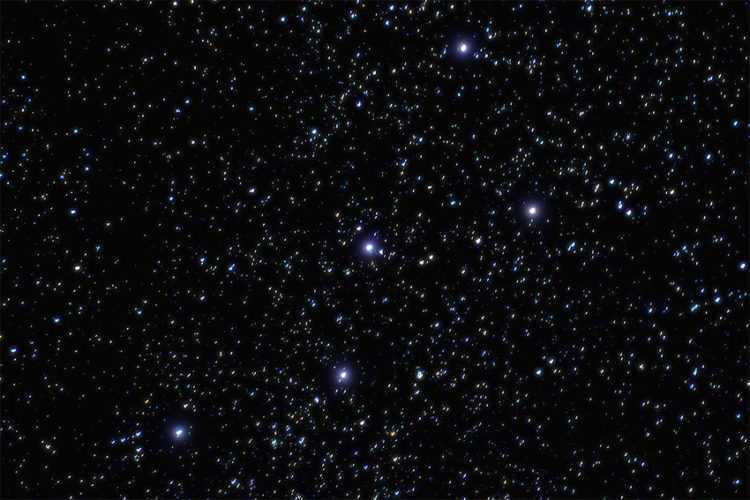
Once upon a time, there was a tale of King Cepheus from Ethiopia. He was married to the stunning yet prideful Cassiopeia. One fine day, Cassiopeia proclaimed that her beauty surpassed that of all the nymphs known as the nerids. This boastful claim offended the nerids, leading them to seek revenge by beseeching Poseidon. Poseidon, in turn, summoned the monstrous Cetus to wreak havoc upon the kingdom.
Upon consulting the Oracle, the king was advised to sacrifice his daughter, Andromeda. While reluctantly following the Oracle’s guidance, Perseus appeared just in time to rescue Andromeda from her impending fate. Filled with gratitude, Andromeda and Perseus decided to unite in marriage. However, their joyous occasion was interrupted by the arrival of Phineas, who also sought Andromeda’s hand in marriage. A fierce battle ensued, but Perseus found himself outnumbered. In a desperate move, he unveiled the head of the fearsome Medusa Gorgon. Both Cepheus and Cassiopeia, unable to avert their gaze, were transformed into stone statues alongside their enemies.
Once every three millennia, the Enchantress of the mystical garden extended an invitation to both gods and mortal beings to partake in the sacred fruits of eternal life. On the designated day, a skilled charioteer harnessed a team of eight spirited horses to a grand chariot, upon which the Empress gracefully settled. With a powerful surge, they soared through the heavens, arriving at the enchanting garden. Upon savoring the divine fruits of immortality, both the Empress and the charioteer became untethered from the constraints of time and lost any longing to return to their earthly abode… They vanished from sight, never to be seen again on the terrestrial plane.
However, the charioteer did not remain in the magical garden. He ascended to the celestial realm, accompanied by his chariot, where the gods transformed him into the celestial constellation known as Cepheus, while his chariot took on the form of the illustrious Big Dipper constellation. Henceforth, every starry night, people from all corners of the Earth can gaze up and witness the immortal charioteer (Cepheus constellation) and his magnificent chariot (Big Dipper constellation) adorning the heavens.
When and where can you spot the constellation Cepheus?
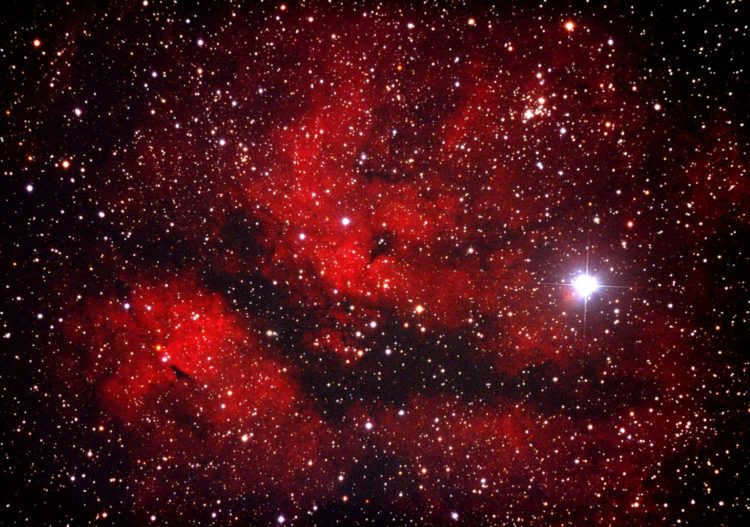
Due to its close proximity to the North Pole, the constellation Cepheus is a unique constellation that can only be observed in Russia. During autumn nights, it can be seen positioned directly overhead. In winter, it appears low in the northwestern-northern region of the sky. In spring, it is visible low in the northern-northeastern part of the sky, while during summer it can be observed high in the northeastern part of the sky.
If you have even a basic knowledge of the star map, you can easily locate the constellation Cepheus by using its neighboring constellations such as the Little Bear, Cassiopeia, Lizard, Dragon, and Swan. Despite the lack of bright stars, with only eight having a stellar magnitude greater than the fourth, on a clear night without the moon’s interference, anyone can observe at least 60 stars within the Cepheus constellation. The best time to observe Cepheus in the southern hemisphere is during the months of July-September. However, due to its strong inclination towards the north, it remains visible throughout the year across the entire territory, including Russia.
Video
can be paraphrased as
Visual Content
.
Cepheus (Latin: Cepheus) is a constellation located in the Northern Hemisphere of the sky, characterized by its irregular pentagon shape. The southern region of this constellation lies along the Milky Way. Covering an area of 587.8 square degrees, Cepheus contains a total of 148 stars that can be observed with the naked eye.
In terms of the movement of the Earth’s North Pole, it gradually shifts towards Cepheus. By the year 3100, the star Alrai (γ Cep) will be in close proximity to the pole. From 5100 to 6500, Alfirk (β Cep) will move even closer to the pole, and by 8300, the star Alderamin (α Cep) will take on the role of the North Pole star.
The constellation Cepheus can be found between Cassiopeia and the Little Bear. The star α Cepheus lies on a straight line that connects α and β of Cassiopeia, and it is four times further away than the distance between these stars.
The optimal time to observe Cepheus is during the months of July to September, and this constellation can be seen in Ukraine and across Russia.
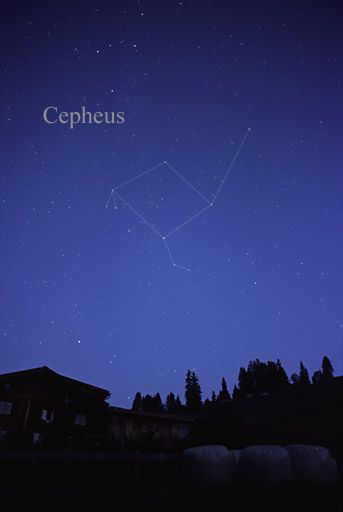
Stellar Objects
The constellation Cepheus lacks prominent stellar objects. The most prominent stellar object is α Ser, also known as Alderamin (2.44m).
The celestial body δ Cep serves as the archetype for an entire class of variable celestial objects known as Cepheids. It undergoes changes in luminosity from 3.5 to 4.4m over a period of 5.37 days. This variable celestial object was discovered by the English amateur astronomer John Goodricke in 1784. Another well-known variable celestial object, Alfirk, serves as the archetype for the β Cepheus class of variables, with a period of 0.19 days (four and a half hours) and an amplitude of only 0.05m.
The constellation contains three red supergiants that are visible to the naked eye:
- VV Cepheus is a binary star system that undergoes eclipses every 20.34 years. The primary component of the system is a massive red giant, which has a diameter 1200 times that of the Sun.
- HR 8164 has an apparent magnitude of 5.66.
- Kruger 60 is a binary star system consisting of two red dwarfs. It has a combined apparent magnitude of 10 and is located only 13 light years away from Earth.
Fascinating items
- The NGC 188 star cluster – is one of the oldest (5 billion years old) of the dispersed clusters of galaxies.
- NGC 6946 — a spiral galaxy where seven supernovae have occurred (more than any other galaxy).
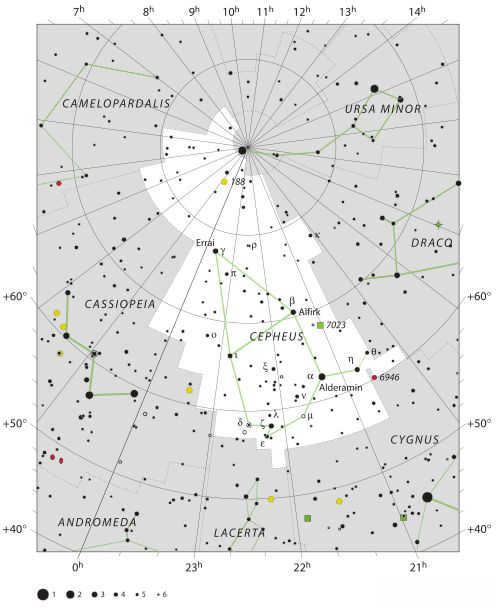
Historical Background
Cepheus constellation is an ancient asterism that has been studied and observed for centuries. It was first described by the Greek astronomer Eudoxus, although his authorship is still a matter of debate among scholars.
In Greek mythology, Cepheus was a legendary king of Ethiopia. He was married to Cassiopeia and together they had a daughter named Andromeda.
This constellation is also featured in Claudius Ptolemy’s famous catalog of the celestial sphere known as Almagest.
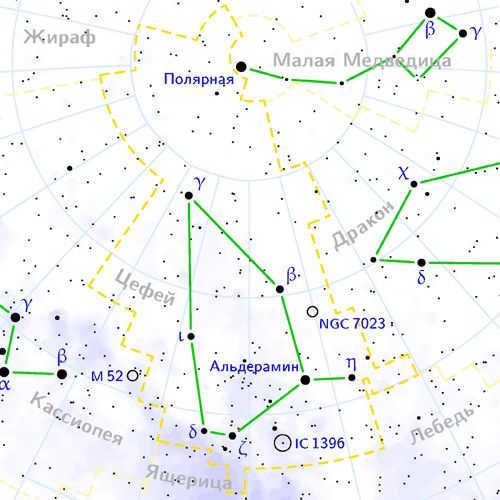
Feel free to click the image to get a closer look at it.
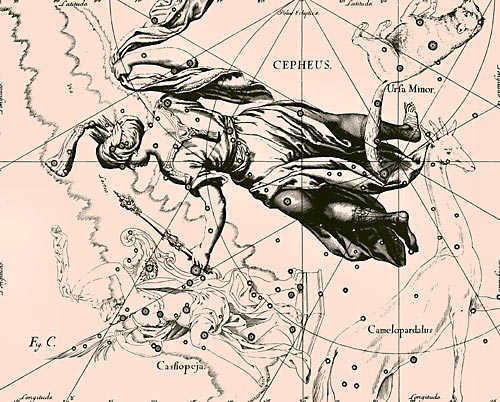
The Uranographia Atlas (1690) by Jan Hevelius showcases the constellation Cepheus.
Feel free to click on the image to get a closer look!
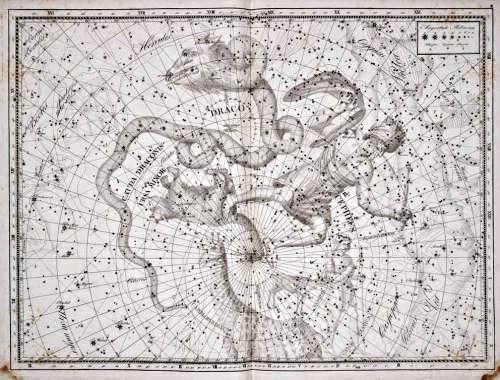
The Cepheus constellation is depicted in the Uranographia Atlas created by J. E. Bode in Berlin in 1801.
Click on the picture to see a larger version.
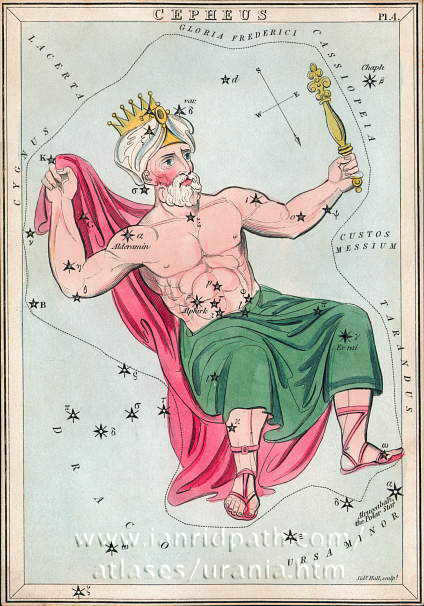
The Cepheus constellation can be seen in the Atlas “Urania’s Mirror” published in London in 1825.
Mythology
According to mythology, there is an interesting legend that connects the constellations Cepheus, Cassiopeia, Andromeda, Cetus, and Perseus.
Long ago, in a distant land known as Ethiopia, King Cepheus (Kepheus) and Queen Cassiopeia ruled over a flourishing kingdom. They were blessed with a beautiful daughter named Andromeda, who was cherished and loved by her parents. Andromeda grew into a stunning young woman, admired for her exceptional beauty that surpassed even the sea nymphs known as Nereids, who were famous for their golden spinning wheels.
Feeling desperate, King Cepheus sought guidance from the oracle on how to rescue his country from the impending disaster. The oracle provided a chilling solution, stating, “The country’s salvation lies in sacrificing your only daughter, Andromeda, to the whale. This is the divine will!”
Overwhelmed with tears and sorrow, Cepheus revealed to Cassiopeia the divine decree. Cassiopeia wept uncontrollably and found herself unable to utter a single word in response. The two of them wept for an extended period of time, but upon witnessing the merciless destruction caused by the monstrous creature, as it transformed the land into a barren wasteland, they resolved not to defy the gods’ will. And so, one morning, even before the rosy-hued Eos parted the gates for Helios to embark upon his majestic golden chariot, Cepheus and Cassiopeia led Andromeda to the rugged coastline. They bound her with chains and secured her to a boulder, leaving her there to sob in grief. Only the gentle rays of Helios delicately caressed Andromeda’s exquisite countenance.
All of a sudden, the ocean became incredibly disturbed. Enormous waves were relentlessly pounding against the rocks along the shore. Emerging from the depths of the sea was an immense whale. It opened its mouth wide, causing fierce flames to erupt from within. Additionally, its lengthy tail, adorned with durable black scales, spun the already tumultuous waves.
Keith witnessed Andromeda perched on the boulder, causing his jaw to drop even wider, revealing teeth as sharp as swords. From its eyes, bolts of bloody lightning shot out. The whale swiftly charged towards the young girl. Andromeda let out a scream of terror. In a matter of moments, the monstrous creature would annihilate her. However, Perseus swiftly descended from the celestial heights, wearing winged sandals, to come to the girl’s rescue. He spotted the approaching monster and heard the girl’s cries as she remained shackled to the rock. Perseus darted towards the creature with an arrow, piercing it with his sword. Yet, this only further incited Kit, who spewed an even more horrendous inferno from its mouth, causing the flames to nearly reach the feet of poor Andromeda. Perseus knew he had no time to waste, so he retrieved the head of the Gorgon Medusa from his enchanted bag. He averted his gaze, ensuring he would not accidentally meet her deadly stare, and directed Medusa’s eyes towards the creature. Instantly, Kit transformed into a massive rocky island situated in the midst of the turbulent sea. Then, Perseus returned Medusa’s head to the sack, shattered the chains that bound Andromeda, and inquired about her identity and the reason for her imprisonment on the rock.
A lavish wedding celebration was arranged at the palace of King Cepheus, unlike anything seen before. The grand halls were illuminated by the torches of Eros and Hymenaeus, casting a golden glow all around. The air was filled with the intoxicating fragrance of flowers and greenery, creating a delightful atmosphere. The sweet melodies of enchanting songs, accompanied by lyres and kiphars, could be heard echoing throughout the palace. Perseus, holding the beautiful goddess Andromeda close, regaled his guests with tales of his heroic adventures. Cepheus and Cassiopeia were overjoyed by the divine intervention that had brought happiness and saved their daughter, as well as their kingdom of Ethiopia, from impending disaster. In gratitude, King Cepheus bestowed upon Perseus a magnificent palace and half of Ethiopia.
Perseus didn’t stay for long in Cepheus’ kingdom. He journeyed alongside Andromeda to the island of Serif to find his mother Danaë. There, he discovered her in a state of deep distress. In order to escape the relentless harassment from Polydectes, she was forced to seek refuge in the temple of Zeus and remained trapped there. Perseus’s heart burned with anger. He confronted Polydectes at the very moment he was feasting with his companions. Polydectes was utterly astonished when he laid eyes on Perseus, as he had been convinced that Perseus wouldn’t return alive from the land of the Gorgons. However, when Perseus informed him that he had slain Medusa Gorgon and brought her head back in a sack, Polydectes nearly died of laughter. “Do you take me for a fool who would believe such a falsehood?” he inquired.
Afterward, Perseus extracted Medusa’s head from the bag. He deliberately averted his gaze, not wanting to be petrified, and declared to Polydectes, “Since you doubt my claims, see for yourself!”
Upon laying eyes on Medusa, Polydectes instantaneously transformed into stone. Likewise, his companions who were reveling alongside him also underwent the same petrification.
Dictys, the brother of Polydectes, who had once rescued Perseus and his mother from the sea, was rewarded with the island of Seriphus by Perseus. Perseus then traveled to Argos with Andromeda and Danaë to visit his grandfather, Acrisius. However, Acrisius, fearing the prophecy that he would be killed by his own grandson, fled to the north. As a result, Perseus took over as ruler of Argos. He returned his helmet to Hades, his winged sandals and magic bag to the nymphs, and his sword to Hermes. Finally, he presented the head of the Medusa Gorgon to Athena Pallada.
The citizens of Argos were delighted with the rule of Perseus and frequently organized games and celebrations to honor him. On a particular day, heroes from all corners of Greece gathered for these games. Even the elderly Acrisius made his way there and watched with immense joy as the young competitors displayed their skills. Perseus himself participated in the games, showcasing his strength by throwing a heavy disk that soared high above the clouds before crashing down with tremendous force upon Acrisius’ head. Thus, the prophecy of the oracle was fulfilled.
The gods, in their divine wisdom, transformed the heroes of this extraordinary tale into celestial bodies, placing them in the sky as the constellations Cepheus, Cassiopeia, Andromeda, Kit, and Perseus.
Many years went by. Ptolemy, the astronomer, transformed the basket into a majestic throne in his celestial map. Perched upon the throne, the Ethiopian queen gracefully revolves around the pole, captivating the gazes of onlookers with the constellation’s splendor.
In Southeast Asia, there is a beautiful legend that connects the constellations of Cepheus and the Big Dipper. According to this tale, the constellation of Cepheus immortalizes a charioteer from ancient times who served one of the great emperors. The charioteer’s incredible journey took him and the empress to the distant mountain of immortality, known as Kuen-Lun, which was said to be located at the very center of the Earth. On this mystical mountain, there existed a magnificent garden belonging to the Mistress of the immortal gods and the Earth. Within this enchanting garden, fairy trees flourished, and no matter the season, it was always filled with an abundance of various fruits. However, the most extraordinary tree in the garden was the peach tree, whose fruit possessed divine powers capable of extending the lifespan of anyone who consumed it.
Once every three thousand years, the Mistress of the enchanted garden extended an invitation to both gods and mortals to partake in the divine fruits of immortality. On the chosen day, a charioteer would harness eight spirited horses to a magnificent chariot, with the empress taking her place upon it, and together they would soar towards the wondrous garden. Once there, the empress and the charioteer would indulge in the fruits of immortality, causing them to lose all sense of time and any desire to return to the mortal realm. From that day forward, they were never seen again on Earth.
However, the charioteer did not remain in the magic garden. He ascended to the heavens along with his chariot, where the gods transformed him into the constellation Cepheus, and his chariot into the constellation known as the Big Dipper. Now, every clear night, people all over the Earth gaze upon the immortal charioteer (Cepheus) and his chariot – the Big Dipper – shining brightly in the sky.
The ruler of Iona, King Cepheus of Ethiopia, who is the husband of Cassiopeia and the father of Andromeda, was faced with a perilous situation when a sea monster (whale/dragon) threatened to devour his daughter. Fortunately, Perseus came to the rescue and saved her.
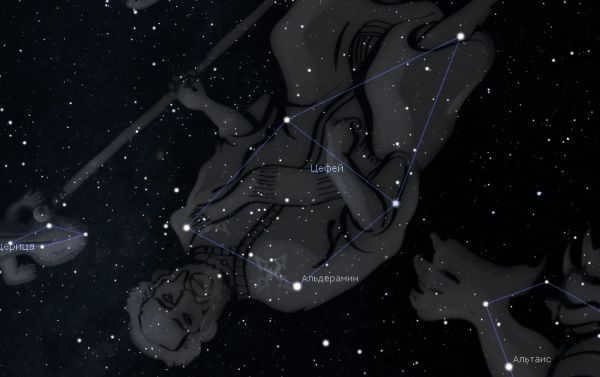
Constellations
The Cepheus constellation is a cluster of celestial objects situated in the northern part of the celestial hemisphere. It takes on the form of an asymmetrical pentagon. Its southern section lies directly on the Milky Way. The region covers an area of 587.8 square degrees and contains a total of 148 stars, which can be observed without the need for specialized equipment.
Origin of the subject in history
The subject of interest can be traced back to the ancient Greek astronomer, Eudoxus of Cnidus, who first mentioned this cosmic group in his manuscripts. Further research and study on the topic were conducted by C. Ptolemy, who classified the group within the Almagest category of celestial bodies.
Mythical Illustration and Story
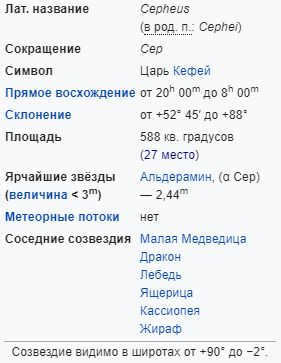
The constellation Cepheus is known for its unique features.
Cepheus, along with his wife Cassiopeia, ruled over a prosperous kingdom in ancient Ethiopia. The legend of Cepheus is intertwined with other constellations such as Andromeda, Perseus, Cetus, and Cassiopeia. Their daughter, Andromeda, was a beloved child who grew up surrounded by the love and care of her parents. Cassiopeia, proud of her daughter’s beauty, would often boast about it to those around her.
King Cepheus found himself in a state of despair. He was at a loss as to how he could rescue Ethiopia from the impending catastrophe. Seeking guidance, he consulted the oracle, who revealed that there was but one solution – sacrificing his daughter Andromeda to a ravenous whale. Cepheus shared this grim prophecy with his wife, and together they wept for hours, uncertain of what course of action to take. Yet, even in their despair, they could not ignore the devastation unfolding before their eyes as the flames engulfed their beloved city. And so, with heavy hearts, they led their cherished daughter to a desolate rocky shore, where they bid her a tearful farewell.
When the ocean rebelled, the whale emerged from its depths, and upon catching sight of the king’s daughter, it widened its fearsome jaws, exposing teeth as sharp as swords. In that moment, Perseus, sensing danger, swiftly flew down from the heavens to rescue the unfortunate maiden. Drawing out the head of Medusa Gorgon, he transformed the monstrous creature into a rocky isle, thus liberating Andromeda. The valiant hero then escorted the young woman to her father’s palace, where her grateful parents granted him permission to take her hand in marriage.
A grand celebration ensued, during which Perseus regaled all with tales of his heroic exploits. However, his sojourn in the realm of Cepheus was destined to be short-lived. Alongside his newly wedded wife, the noble savior embarked on a journey to Seriphus to reunite with his mother, Danae, who was languishing in captivity. One fateful day, Perseus revealed to the residents of his household that he had successfully vanquished Medusa Gorgon. Met with disbelief, he promptly turned each and every doubter to stone.
Meanwhile, Perseus, along with his wife and mother, journeyed to Argos to reunite with his grandfather and assume the throne. The citizens were overjoyed by this news, prompting the royal court to host extravagant festivities and sporting events on a regular basis. It was during one of these celebrations that Perseus tossed a disc skyward, and upon its descent, it transformed all those present into constellations. As a result, multiple clusters of celestial bodies emerged simultaneously.
Main characteristics
The constellation Cepheus possesses the following distinctive features:
- Its Latin name is CEPHEUS, and it can be abbreviated as CEP;
- The time interval during which it is in direct ascension is from 20.00 to 8.00;
- The declination period ranges from 52.45 to 88 degrees;
- There are approximately 60 stars with a brightness parameter of 6 units;
- The most favorable visibility is observed from +90 to -2 degrees;
- It is situated in the northern hemisphere.
Throughout the year, this constellation can be observed from Belarus, Russia, and Ukraine.
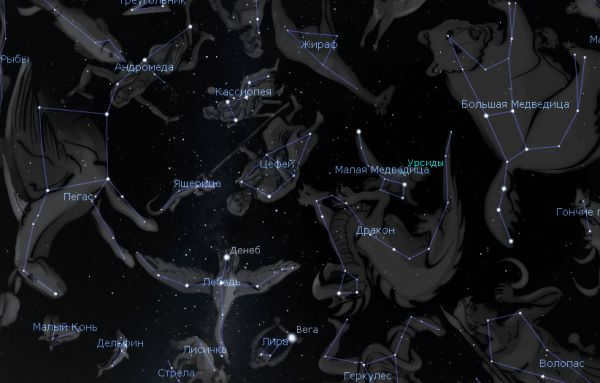
Constellation Cepheus offers a variety of fascinating objects to observe.
Noteworthy celestial sights
Cepheus constellation boasts an impressive array of captivating subjects.
One such object is the NGC 7023 nebula, also known as Iris. This diffuse cluster can be found in the C4 region.
Another remarkable sight is the NGC 6951 spiral galaxy, which dazzles with its small size and breathtaking beauty. It has a visible magnitude of 11 units, although in certain circumstances this figure can reach 10.65 min.
Lastly, the NGC 6939 scattered cluster is worth exploring. Positioned on the border of several prominent stellar groups, including Cepheus, Dragon, and Swan, it is surrounded by high-brightness objects, making it convenient to locate and observe.
NGC 7142 is a group of stars that are scattered across the sky. Another interesting object is NGC 7129, which is a nebula that reflects light. Although NGC 7142 itself does not have any notable features, the surrounding area is worth noting because of the presence of faint, distant stars. Additionally, there are bright stars nearby that can be easily seen without a telescope.
The NGC 7160 cluster is similar to NGC 7142 in that it is also a scattered group of stars. It is small in size but has a significant brightness. The shape and outline of this cluster are easily memorable.
IC1 396 is an emission nebula that is currently undergoing active star formation. It spans over several light-years and has a stellar magnitude of 3.6 units. Its size is measured at 12.0*8.0 units.
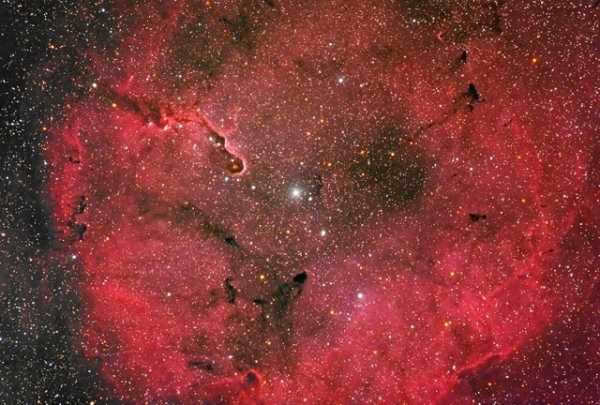
IC 1396 is a nebula found in the constellation Cepheus, also known as the “Grotto”. To catch a glimpse of this celestial wonder, one must wait for a perfectly clear night sky and have a powerful telescope with a minimum of 200+ magnification.
NGC 7235, a scattered cluster. This cluster has an apparent size of 4.0 and a brightness level of 7.7 units. The stars within this cluster are bright and exhibit pulsating characteristics.
NGC 7226, a cluster. This cluster is not particularly notable and can be difficult to identify. It is located near the constellation known as the “Lizard”.
A group of stars called NGC 7261 is scattered across the sky. If you move slightly to the west, you can locate this collection of stars, which is hidden among numerous other bright objects and consists of 100 stars.
There is a cluster with a nebula known as “Sorcerer,” or NGC 7380. This group of stars has a substantial size of 20 units and a relatively high stellar magnitude of 7.2.
NGC 7354 is a planetary nebula located in the constellation Cepheus. This nebula has a bright appearance and is easy to remember. However, specific technical data about this cosmic object is not available.
A group of stars, dispersed NGC 7510. This object resides on the border with Cassiopeia and consists of approximately 80 stars with varying levels of brightness. There are several hot entities present, while the remainder are cooler.
Emission nebula NGC 7538. It may not be as well-known as its “siblings”, but it is currently a popular group of luminaries. It has several alternative names – “Northern Lagoon”, “Headbrain”. Its visible size measures 9.0*6.0, and its stellar magnitude approaches 10.
Cluster NGC 7762. It possesses impressive size characteristics and a faint appearance. It encompasses around one hundred stellar objects. The brightest component has a brightness index of 10 units.
A collection of dispersed celestial bodies known as NGC 188 (C1). Despite being a well-studied entity, there has been a lack of recent updates regarding this phenomenon. According to recent calculations, it is estimated to be approximately 5 billion years old. The cluster consists of more than one hundred stars, with an apparent magnitude of 15.0 units and a brightness parameter of 8.1.
The stars of this object are directly linked to the rare category. Their spectrum shows a blue shift without any change in brightness. This occurrence can be explained by the existence of a dwarf component within the system in question. The older star emits stardust to the nearby object, causing it to grow in size and heat up. Consequently, after a certain period of time, the object burns out and transforms into a white dwarf.
The constellation Cepheus is home to numerous distinctive objects that warrant special attention and observation. Some of them have been extensively examined and are no longer of interest to modern-day science. However, certain groups of stars still hold unknown information and are being actively studied by experts.
Description of Multiple Star Systems
Cepheus constellation encompasses several systems of multiple nature, in addition to the mentioned objects.
The binary star CER consists of a primary component with a luminosity index of 4.6 and a secondary luminary with a brightness of 6.5 units. The angular separation between the objects is 8.5 units. To distinguish them, a telescope with a minimum magnification of 200x will be required.
Omicron is a binary star system. It consists of a primary star with a luminosity level of 4.9 units and a companion star with a brightness value of 7.1 minutes. The angular distance between the two stars is 3.1 seconds. Despite the high brightness and close proximity of the stars, it is possible to use a light filter when observing them. This filter will reduce the backlight and make the brightest objects appear as dots.
Delta is another binary star system. The primary star in this system is a pulsating variable star. It can change its brightness between 3.5 and 4.4 units over a period of 24 hours. The system also includes a white dwarf star. The distance to this system is approximately 890 light-years.
So, there are numerous characteristics and intricacies associated with the constellation Cepheus. The information provided in this article is by no means comprehensive. It encompasses a wide range of diverse topics.
Within this vast expanse of the universe, there are various celestial objects that capture our imagination. These include galactic spaces, planetary-scale nebulae, and clusters. Although there is already a wealth of scientific knowledge about these phenomena, they continue to be subject of ongoing research and exploration. Experts are convinced that there are still many fascinating discoveries waiting to be made.
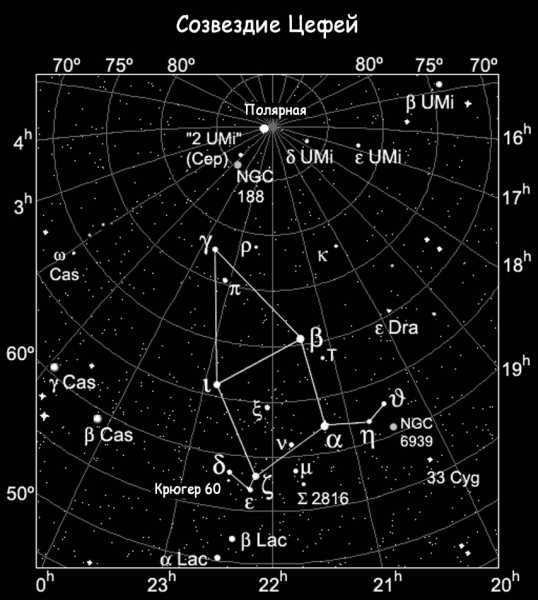
What is there to know about this constellation for those who are unfamiliar with it? Well, Cepheus is a constellation that can be found near the pole and is situated in the sky of the Northern Hemisphere.
The configuration of the Cepheus constellation is reminiscent of a somewhat irregular pentagon. It becomes even more vivid if you envision it as a house with a roof (consisting of a square and a triangle) drawn on a piece of paper, like we used to do in our childhood. By flipping it over, you can readily spot a comparable depiction in the night sky.
Where and when can you see the Cepheus constellation?
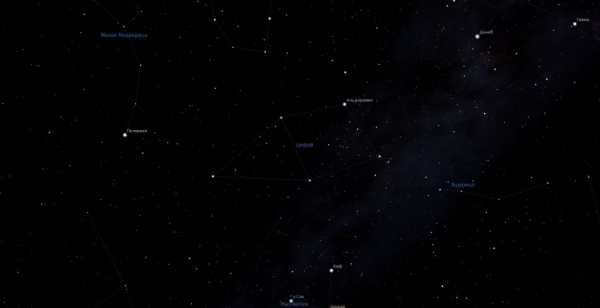
Cepheus, as seen in the planetarium program
If you have some knowledge about the night sky map, you can easily locate the constellation Cepheus by navigating through its neighboring constellations: Ursa Minor, Cassiopeia, Lacerta, Draco, and Cygnus. This constellation doesn’t have many bright stars, with only eight of them having a magnitude greater than four. However, on a clear night without the moon, anyone can observe at least 60 stars in the Cepheus constellation. The best time to observe Cepheus in the southern hemisphere is from July to September. However, since Cepheus is highly inclined to the north, it can be well seen throughout the year in places like Russia.
The upcoming polar star in the constellation of Cepheus.
The movement of the North Pole of the world
As we mentioned earlier, due to the shift of the axis, the star alpha Cepheus is expected to become the polar star in approximately 4,000 years. This is significant because Alderamin, despite having a stellar magnitude of only 2.45m, is the brightest star in this constellation. It is easily visible to the naked eye, even in areas with excessive light pollution. Alderamin is located 49 light years away from Earth. The name of this celestial object, which translates to “right hand” in Arabic, adds to its allure and beauty.
Alpha Cepheus
Alpha Cepheus is the brightest star in the constellation Cepheus. It is a binary star system consisting of two stars, Alpha Cepheus A and Alpha Cepheus B. The two stars orbit around their common center of mass and are separated by a distance of about 17 astronomical units. Alpha Cepheus A is a blue-white supergiant star, while Alpha Cepheus B is a yellow-white dwarf star. The combined visual magnitude of the system is 3.23, making it easily visible to the naked eye. Alpha Cepheus is located about 49 light-years away from Earth.
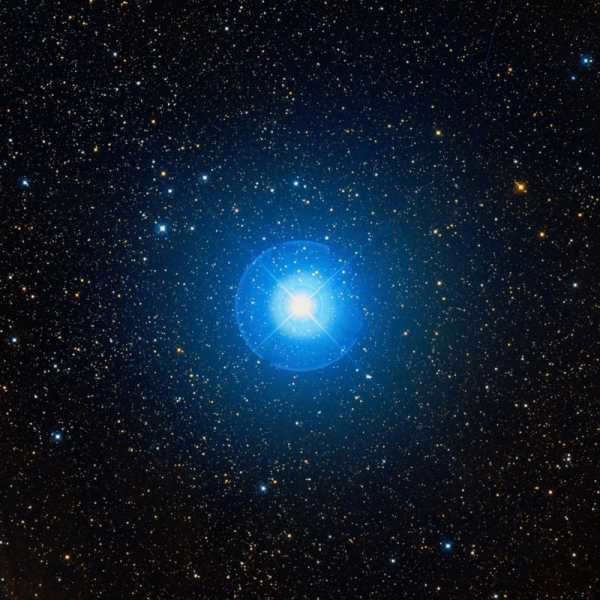
When discussing the astronomical categorizations of Alpha Cepheus, it is important to mention that it is a typical A-class white star. Its classification as a subgiant is due to its level of luminosity. There is evidence to suggest that Alderamin is in the process of becoming a red giant, as its hydrogen reserves are running low. Based on the distance between Alpha Cepheus and Earth, as well as its surface temperature of 7500 K, we can infer the following about its characteristics. The radius of the star is estimated to be two and a half times that of the Sun, and it has a mass of 1.9 times that of the Sun. Alderamin’s total luminosity is approximately 19 times that of the Sun. Like other stars in its classification, Alpha Cepheus is also a variable star.
The star’s rotation speed is extremely high, reaching a minimum of 246 km/s. This implies that it completes a full revolution every 12 hours. Such rapid rotation indicates a deceleration in the dispersion of chemical elements within the star’s composition. In comparison, our Sun completes a full revolution in a month, yet both Alderamin and the Sun exhibit similar levels of X-ray radiation. Considering other factors, we can infer an elevated magnetic activity in Cepheus alpha, which is highly uncommon for rapidly rotating stars.
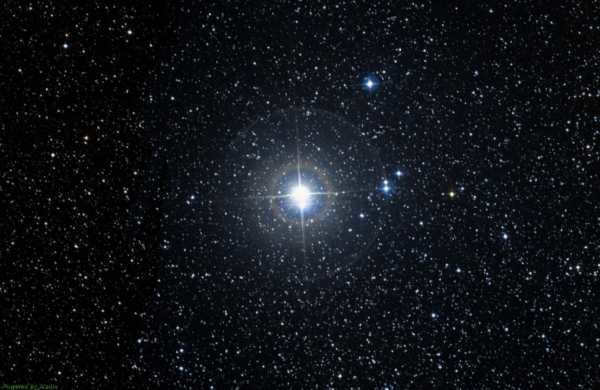
One fascinating star in this constellation is Cepheus delta. This star is known as Aldarif, a name derived from the Arabic word for “next”. Delta Cepheus is a common binary star located approximately 891 light-years from our planet. The Aldarif star served as the precursor for a complete group of pulsating variable magnitude stars known as Cepheids. The variability of delta Cepheid was first observed in 1784 by a remarkably young scientist named Goodricke.
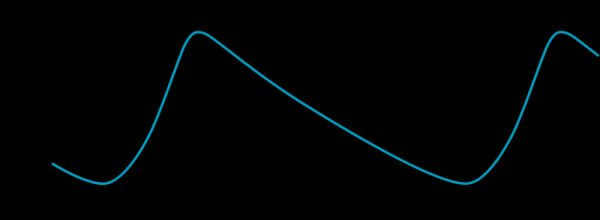

The light curve of the star δ Cepheus
The brightness of this star varies with a period of 5 days and 9 hours. It is important to note that the increase in luminosity occurs much quicker than its decrease. The highest magnitude of the Aldarif star is 3.5m, while the lowest is 4.4m. Studies of the spectrum of this celestial body have revealed intriguing and even contradictory characteristics. It is known that during the minimum luminosity phase, delta Cepheus becomes a typical representative of G2 spectral class stars (similar to the Sun), but during the maximum phase, it transforms into a F5 class luminary. One might conclude that Aldarif is a binary star, but its light curve is quite different from that of spectrally binary stars.
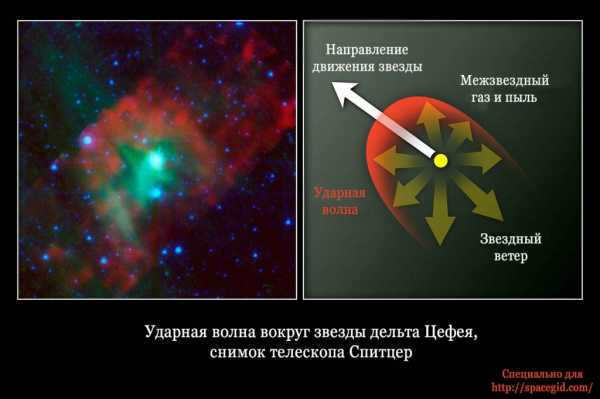
A shock wave originating from the star Delta Cepheus has been discovered.
Scientists have uncovered a key to understanding this peculiar behavior of the star: it undergoes pulsations, alternately contracting and expanding, resulting in a change in its diameter by millions of kilometers. Its radius, which is approximately 40 times that of the Sun, varies by four solar radii during these pulsations. As Delta Cepheus contracts, it experiences a rise in temperature, causing a shift in its spectral properties. Despite the decrease in its emission surface, the star becomes significantly brighter. Conversely, during expansion, Delta Cepheus exhibits the opposite behavior. Stars similar to Delta Cepheus, known as Aldarif-like stars, have masses ranging from 3 to 30 times that of the Sun and have mostly evolved beyond the main sequence of stellar evolution.
Delta Cepheus B
can be rephrased as “
Second star of the Cepheus constellation
“.
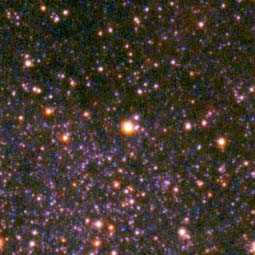
Aldarif’s partner star is known as Delta Cepheus B. It has a magnitude of 7.5m. Delta Cepheus B is situated at a distance of twelve thousand astronomical units from the primary star.
This companion star takes approximately 500 years to complete one orbit. It is visible in the sky even with a compact telescope.
The mighty star – mu Cepheus

Comparison of the sizes of μ Cepheus and the Sun
The following star lacks a commonly known “popular” name, except for its association with a constellation, namely Mu Cepheus. It is frequently referred to as Herschel’s Garnet Star, named after the scientist William Herschel, who observed its vibrant color. This star is classified as a red supergiant. It is one of the largest and most powerful stars in the Milky Way, with a luminosity that is approximately 350,000 times greater than that of the Sun. Mu Cepheus is designated as spectral class M2Ia.
Characteristics of Mu Cepheus
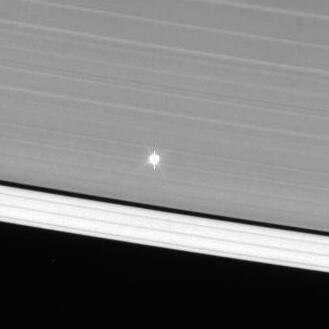

The star Mu Cepheus can be seen through Saturn’s rings, as shown in the Cassini image taken on July 3, 2013.
Mu Cepheus is a part of a triple star system. Apart from the main star, there are two other components in this system: mu Cepheus B, which has an apparent stellar magnitude of 12.3m, and mu Cepheus C, with a stellar magnitude of 12.7m. It is worth noting that this star is currently in its final stage of evolution.
The process of burning helium has already commenced, leading to its subsequent conversion into carbon, providing undeniable proof of its impending demise. It is highly probable that within the next several million years, it will undergo a catastrophic explosion, giving rise to a supernova and potentially resulting in the formation of a black hole from its massive core.
Hypergiant in the constellation Cepheus
As you may have already noticed, the constellation Cepheus is truly one-of-a-kind when it comes to its stellar composition. Another fascinating aspect of this constellation is the star VV Cepheus, which is a binary eclipsing star situated just 5000 light years away from Earth. In fact, its component A is the third largest star in terms of radius and the second largest in terms of size in the entire Milky Way galaxy!
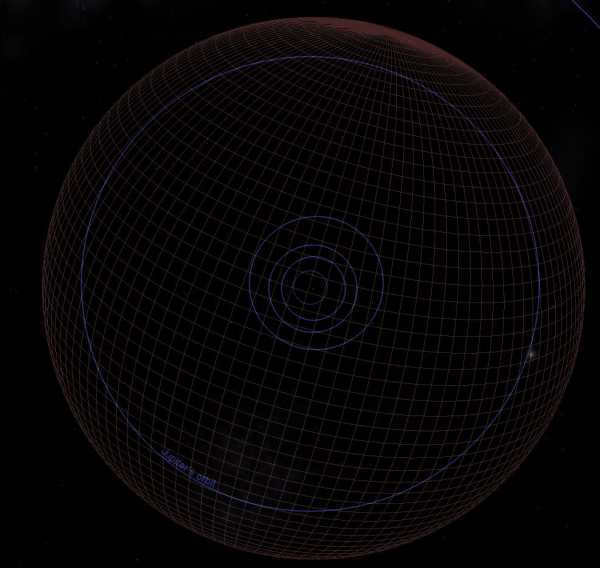
VV of Cepheus A in comparison to Jupiter’s orbit
So, VV Cepheus A is a highly uncommon red hypergiant, classified as an M2 spectral class. Within the entire galaxy, this star is the second largest, only surpassed by the giant VY in the constellation Canis Major. It has a diameter approximately 1800 times greater than that of the Sun, on average, and its luminosity ranges from 275,000 to 575,000 times greater than that of the Sun. Component A of this star has been scientifically confirmed to be a physically variable star that pulsates with a period of 150 days. By estimating the star’s orbital motion, we can deduce that its mass is equivalent to 100 solar masses, although, considering its luminosity, we can only estimate it to be around 25-40 solar masses.
VV Cepheus B
Rephrased Text:
VV Cepheus B – A Unique Celestial Object
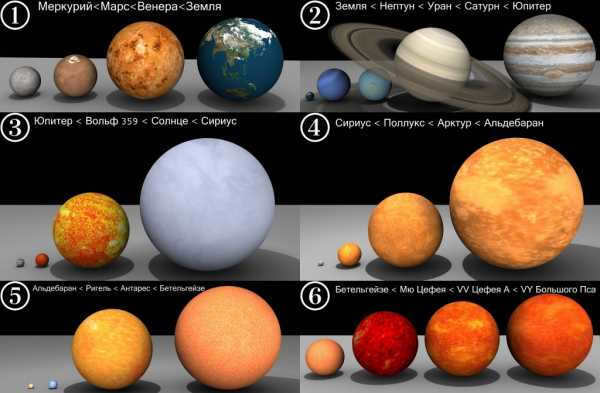
VV Cepheus B is the second part of the star in question. It was discovered in 1936 that this star is not only a binary system, but also an eclipsing variable. Eclipses of the B component have been observed every twenty years since then. VV Cepheus B is a blue star and belongs to the main sequence in spectral class B0. It revolves around the A component in an elliptical orbit. The complete orbit takes approximately 7430 days, which is equivalent to about twenty years. The eclipse of component A by component B lasts for approximately 3.6 years. The diameter of VV Cepheus B is approximately ten times larger than that of the Sun, and its luminosity is a hundred thousand times greater. The distance between the two components of VV Cepheus varies from 17 to 34 astronomical units.
Kruger 60 is not portrayed as a villain, rather, it is a celestial body located within the constellation Cepheus
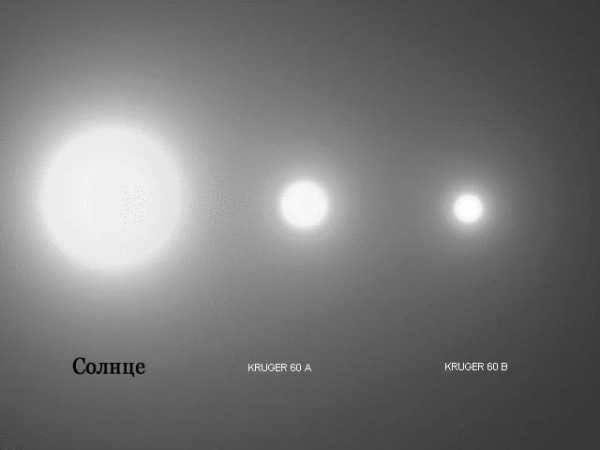
Comparative sizes of Kruger 60 A and B stars and the Sun
Another fascinating star in the constellation being discussed is Kruger 60 or DO Cepheus. It is a binary system located thirteen light years away from the Sun. The system consists of two red dwarfs that share a common center of mass and orbit around it. The orbital period of rotation is approximately 45 years. The larger star in Kruger 60 is referred to as A, while the smaller one is known as B. Kruger B is classified as a flaring star, with flares occurring every 8 minutes. During a flare, Kruger B becomes twice as bright before returning to its normal state.
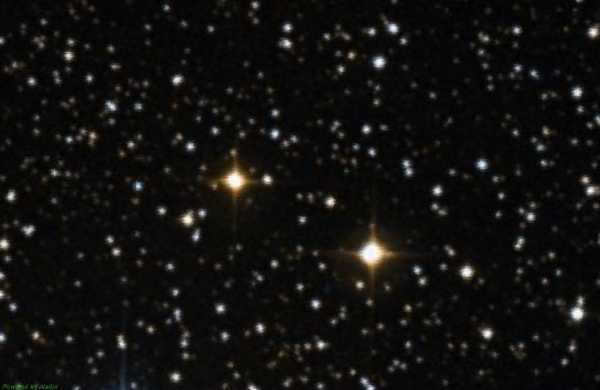
The parameters of the Kruger 60 star’s components are as follows: component A has a mass of approximately 27% of the mass of the Sun and a radius of approximately 35% of the Sun’s radius. On the other hand, component B has a mass equal to 18% of the Sun’s mass and a radius that is approximately 24% of the Sun’s radius. The average distance between Kruger A and Kruger B is 9.5 astronomical units, which is approximately the same distance as that between Saturn and the Sun. Nonetheless, the orbit of the Kruger 60 star exhibits some eccentricity, thus resulting in the aforementioned distance being able to fluctuate between 5.5 and 13.5 astronomical units.
Other notable attractions in Cepheus
NGC 188: A dispersed constellation of stars
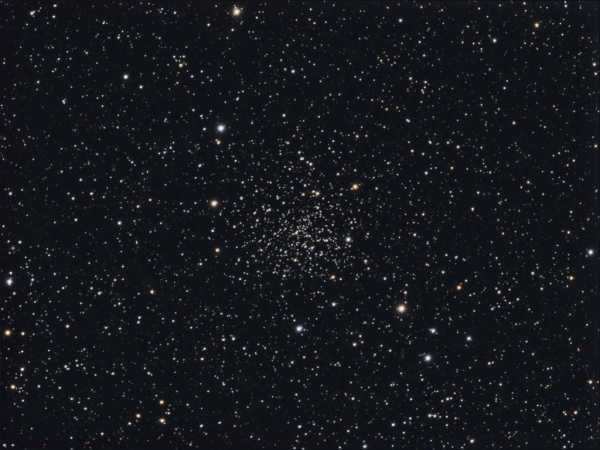
In addition to the stunning stars, Cepheus is abundant in various other celestial objects. Of particular fascination is the dispersed cluster known as NGC 188. It is incredibly rare to come across a cluster as ancient as this, with estimates suggesting it is at least 5 billion years old. Comprising approximately 120 stars, this cluster is located a staggering six thousand light years away from our planet.
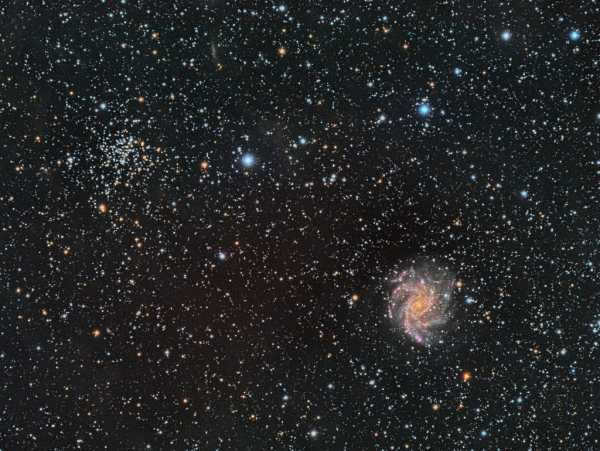
NGC 6946, also known as Fireworks, is a captivating spiral galaxy that has caught the attention of not only astronomers, but also the general public. Situated 22 million light years away from us, this extraordinary galaxy was first observed by the renowned scientist Herschel in 1768. What makes this spiral galaxy truly unique is the fact that it has witnessed the eruption of an astounding 9 supernovae, surpassing any other galaxy in terms of this spectacular phenomenon!
Alongside NGC 6946, positioned to the left and above, we have the pleasure of gazing at the mesmerizing scattered star cluster NGC 6939.
Background
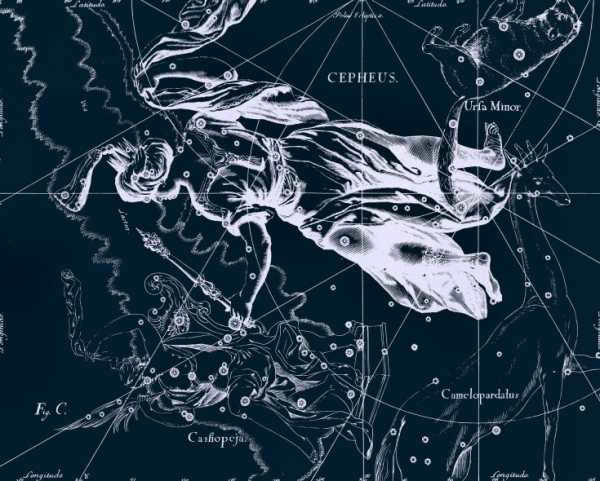
The constellation Cepheus is closely connected with Greek mythology, particularly with the constellations of Andromeda, Cassiopeia, and Perseus. According to the myth, Cepheus was the Ethiopian king who was married to Cassiopeia and was the father of Andromeda, who was saved by Perseus from a monster. However, there are some indications that suggest a later origin of this celestial object.





